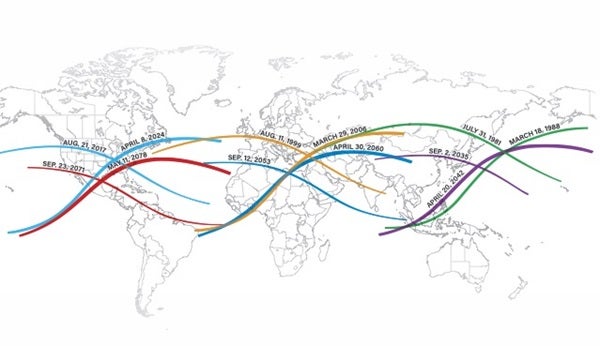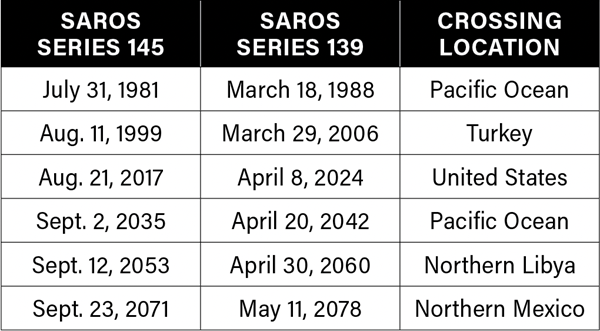The next U.S. Total solar eclipse, which is in 2024, intersects the path of the 2017 eclipse and the duration of totality will also be close to 2017’s. Is it a common occurrence to have two eclipses bisect with similar maximum totality durations?
As it turns out, the Moon, Earth, and Sun return to approximately the same geometry about every 18 years 11 days or so, depending on the number of leap years during such eclipse cycles. This period of time is known as the saros. And yes, it is common for intersecting eclipses to more or less duplicate after that period of time.
So, the 2017 and 2024 eclipses, which cross because they travel across the U.S. in different directions, are only the latest in a long line of such crossings.
The 2017 eclipse is part of saros series 145 and the 2024 eclipse is part of series 139. You can calculate the next pair of intersecting eclipses in these series by adding another eclipse cycle — again, that’s 18 years 11 days — to each. Where these eclipse crossings will land follows their own pattern, crossing in the same general vicinity every three saroses.
The totalities of each saros series are also similar, with saros 145 eclipses lasting between 23/4 and 31/4 minutes, while saros 139 eclipses last between about 41/2 and 51/2 minutes.
As to why these mirroring eclipses occur, it boils down to cosmic coincidence. A lunar month — the time it takes for the Moon to complete one phase cycle, in this case New Moon to New Moon — lasts about 29 days 12 hours 44 minutes 3 seconds. A draconic month — so named after the belief that eclipses were caused by a dragon eating the Sun — is the time it takes for the Moon to orbit the Earth and recross the ecliptic, the path of the Sun in our sky. This occurs about every 27 days 5 hours 5 minutes 36 seconds. After a saros, the two periods are only off by about 52 minutes, making for similar eclipse paths. So if the eclipse paths of two different saros series happen to cross, they will do so in each successive cycle.
The length of totality depends on the size of the Moon’s shadow on Earth, which in turn hinges on how far away from Earth the Moon happens to be. The elliptical period is about 27 days 13 hours 18 minutes 33 seconds. After one saros, it too happens to be very closely aligned with the lunar and draconic months, off by only a few hours. The minor differences do eventually build up, however. A saros series typically only lasts somewhere between 1,226 and 1,550 years.
I have posted links to dual-path maps on my website for the International Astronomical Union’s Working Group on Eclipses at http://eclipses.info as well as on my own Williams College eclipse website at http://totalsolareclipse.org.











